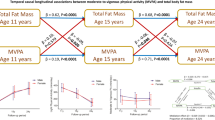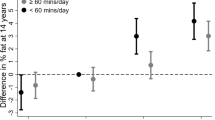Abstract
Background/Objectives:
We hypothesized that maternal size during pregnancy and birth size are determinants of childhood physical activity energy expenditure (PAEE). Also, childhood PAEE is inversely related to adiposity and levels of cardiovascular risk factors.
Subjects/Methods:
The Vulnerable Windows Cohort Study is a longitudinal observational study of 569 Afro-Jamaican mothers recruited from the first trimester and their offspring. Anthropometry, bioelectrical impedance, PAEE (using the Actical monitor) and cardiovascular risk factors (blood pressure, fasting glucose, insulin and lipids) were measured in 124 boys and 160 girls at a mean age of 13.2 years.
Results:
Boys had more fat-free mass (FFM) and expended more energy than girls (12.3±3.3 vs 9.6±2.8 kcal/kg/day; P<0.001). Maternal weight was associated with child's PAEE (r=0.29; P<0.001). PAEE was not significantly associated with birth weight. Maternal weight, after adjusting for child's age and sex, was positively associated with the child's FFM, fat mass and %fat (P-values ⩽0.01). Age- and sex-adjusted PAEE was positively associated with FFM, fat mass and % fat (P-values <0.001), but not after adjusting for current weight. Age- and sex-adjusted PAEE was positively associated with triglycerides, insulin and systolic blood pressure (P-values <0.05), but not after adjusting for weight and height. PAEE was associated with fasting glucose after controlling for age, sex, weight and height (r=−0.12; P=0.02).
Conclusions:
Maternal size, but not birth weight, is a determinant of childhood PAEE. PAEE is not strongly associated with childhood body composition, but is inversely related to fasting glucose concentration.
This is a preview of subscription content, access via your institution
Access options
Subscribe to this journal
Receive 12 print issues and online access
$259.00 per year
only $21.58 per issue
Buy this article
- Purchase on Springer Link
- Instant access to full article PDF
Prices may be subject to local taxes which are calculated during checkout


Similar content being viewed by others
References
Andersen LB, Harro M, Sardinha LB, Froberg K, Ekelund U, Brage S et al. (2006). Physical activity and clustered cardiovascular risk in children: a cross-sectional study (The European Youth Heart Study). Lancet 368, 299–304.
Carrel AL, Clark RR, Peterson SE, Nemeth BA, Sullivan J, Allen DB (2005). Improvement of fitness, body composition, and insulin sensitivity in overweight children in a school-based exercise program: a randomized, controlled study. Arch Pediatr Adolesc Med 159, 963–968.
DeLany JP, Harsha DW, Kime JC, Kumler J, Melancon L, Bray GA (1995). Energy expenditure in lean and obese prepubertal children. Obes Res 3 (Suppl 1), 67–72.
DeLany JP, Bray GA, Harsha DW, Volaufova J (2004). Energy expenditure in African American and white boys and girls in a 2-y follow-up of the Baton Rouge Children's Study. Am J Clin Nutr 79, 268–273.
Eck LH, Klesges RC, Hanson CL, Slawson D (1992). Children at familial risk for obesity: an examination of dietary intake, physical activity and weight status. Int J Obes Relat Metab Disord 16, 71–78.
Ekelund U, Brage S, Froberg K, Harro M, Anderssen SA, Sardinha LB et al. (2006). TV viewing and physical activity are independently associated with metabolic risk in children: the European Youth Heart Study. PLoS Med 3, e488.
Froberg K, Andersen LB (2005). Mini review: physical activity and fitness and its relations to cardiovascular disease risk factors in children. Int J Obes (Lond) 29 (Suppl 2), S34–S39.
Gale CR, Javaid MK, Robinson SM, Law CM, Godfrey KM, Cooper C (2007). Maternal size in pregnancy and body composition in children. J Clin Endocrinol Metab 92, 3904–3911.
Gluckman PD, Hanson MA, Cooper C, Thornburg KL (2008). Effect of in utero and early-life conditions on adult health and disease. N Engl J Med 359, 61–73.
Goran MI, Hunter G, Nagy TR, Johnson R (1997). Physical activity related energy expenditure and fat mass in young children. Int J Obes Relat Metab Disord 21, 171–178.
Hallal PC, Wells JC, Reichert FF, Anselmi L, Victora CG (2006). Early determinants of physical activity in adolescence: prospective birth cohort study. Br Med J 332, 1002–1007.
Harvey NC, Poole JR, Javaid MK, Dennison EM, Robinson S, Inskip HM et al. (2007). Parental determinants of neonatal body composition. J Clin Endocrinol Metab 92, 523–526.
Jackson M, Samms-Vaughn M, Ashley D (2002). Nutritional status of 11–12 -year-old Jamaican children: coexistence of under and overnutrition in early adolescence. Public Health Nutr 5, 281–288.
Knowler WC, Barrett-Connor E, Fowler SE, Hamman RF, Lachin JM, Walker EA et al. (2002). Reduction in the incidence of type 2 diabetes with lifestyle intervention or metformin. N Engl J Med 346, 393–403.
Kotz CM (2006). Integration of feeding and spontaneous physical activity: role for orexin. Physiol Behav 88, 294–301.
Kotz CM, Wang C, Teske JA, Thorpe AJ, Novak CM, Kiwaki K et al. (2006). Orexin A mediation of time spent moving in rats: neural mechanisms. Neuroscience 142, 29–36.
Leman CR, Adeyemo AA, Schoeller DA, Cooper RS, Luke A (2003). Body composition of children in south-western Nigeria: validation of bio-electrical impedance analysis. Ann Trop Paediatr 23, 61–67.
Levine JA, Eberhardt NL, Jensen MD (1999). Role of nonexercise activity thermogenesis in resistance to fat gain in humans. Science 283, 212–214.
Lohman TG, Ring K, Schmitz KH, Treuth MS, Loftin M, Yang S et al. (2006). Associations of body size and composition with physical activity in adolescent girls. Med Sci Sports Exerc 38, 1175–1181.
Luke A, Durazo-Arvizu RA, Cao G, Forrester TE, Wilks RJ, Schoeller DA et al. (2007). Activity, adiposity and weight change in Jamaican adults. West Indian Med J 56, 398–403.
Luke A, Durazo-Arvizu RA, Rotimi CN, Iams H, Schoeller DA, Adeyemo AA et al. (2002). Activity energy expenditure and adiposity among black adults in Nigeria and the United States. Am J Clin Nutr 75, 1045–1050.
Luke A, Philpott J, Brett K, Cruz L, Lun V, Prasad N et al. (2004). Physical inactivity in children and adolescents: CASM Ad Hoc Committee on Children's Fitness. Clin J Sport Med 14, 261–266; discussion 260.
Marshall WA, Tanner JM (1969). Variations in pattern of pubertal changes in girls. Arch Dis Child 44, 291–303.
Marshall WA, Tanner JM (1970). Variations in the pattern of pubertal changes in boys. Arch Dis Child 45, 13–23.
Mattocks C, Ness A, Deere K, Tilling K, Leary S, Blair SN et al. (2008). Early life determinants of physical activity in 11 to 12 year olds: cohort study. Br Med J 336, 26–29.
McMurray RG, Harrell JS, Deng S, Bradley CB, Cox LM, Bangdiwala SI (2000). The influence of physical activity, socioeconomic status, and ethnicity on the weight status of adolescents. Obes Res 8, 130–139.
Metcalf BS, Voss LD, Wilkin TJ (2002). Accelerometers identify inactive and potentially obese children (EarlyBird 3). Arch Dis Child 87, 166–167.
Novak CM, Kotz CM, Levine JA (2006a). Central orexin sensitivity, physical activity, and obesity in diet-induced obese and diet-resistant rats. Am J Physiol Endocrinol Metab 290, E396–E403.
Novak CM, Zhang M, Levine JA (2006b). Neuromedin U in the paraventricular and arcuate hypothalamic nuclei increases non-exercise activity thermogenesis. J Neuroendocrinol 18, 594–601.
Obarzanek E, Schreiber GB, Crawford PB, Goldman SR, Barrier PM, Frederick MM et al. (1994). Energy intake and physical activity in relation to indexes of body fat: the National Heart, Lung, and Blood Institute Growth and Health Study. Am J Clin Nutr 60, 15–22.
Popkin BM (2004). The nutrition transition: an overview of world patterns of change. Nutr Rev 62, S140–S143.
Purslow LR, Hill C, Saxton J, Corder K, Wardle J (2008). Differences in physical activity and sedentary time in relation to weight in 8–9 year old children. Int J Behav Nutr Phys Act 5, 67.
Puyau MR, Adolph AL, Vohra FA, Zakeri I, Butte NF (2004). Prediction of activity energy expenditure using accelerometers in children. Med Sci Sports Exerc 36, 1625–1631.
Ravussin E, Danforth Jr E (1999). Beyond sloth—physical activity and weight gain. Science 283, 184–185.
Riddoch CJ, Bo Andersen L, Wedderkopp N, Harro M, Klasson-Heggebo L, Sardinha LB et al. (2004). Physical activity levels and patterns of 9- and 15-yr-old European children. Med Sci Sports Exerc 36, 86–92.
Riddoch CJ, Mattocks C, Deere K, Saunders J, Kirkby J, Tilling K et al. (2007). Objective measurement of levels and patterns of physical activity. Arch Dis Child 92, 963–969.
Rising R, Harper IT, Fontvielle AM, Ferraro RT, Spraul M, Ravussin E (1994). Determinants of total daily energy expenditure: variability in physical activity. Am J Clin Nutr 59, 800–804.
Rogers M, Fay TB, Whitfield MF, Tomlinson J, Grunau RE (2005). Aerobic capacity, strength, flexibility, and activity level in unimpaired extremely low birth weight (<or=800 g) survivors at 17 years of age compared with term-born control subjects. Pediatrics 116, e58–e65.
Rowlands AV, Ingledew DK, Eston RG (2000). The effect of type of physical activity measure on the relationship between body fatness and habitual physical activity in children: a meta-analysis. Ann Hum Biol 27, 479–497.
Rowlands AV, Pilgrim EL, Eston RG (2008). Patterns of habitual activity across weekdays and weekend days in 9–11-year-old children. Prev Med 46, 317–324.
Sallis JF, Prochaska JJ, Taylor WC (2000). A review of correlates of physical activity of children and adolescents. Med Sci Sports Exerc 32, 963–975.
Schulz LO, Harper IT, Smith CJ, Kriska AM, Ravussin E (1994). Energy intake and physical activity in Pima Indians: comparison with energy expenditure measured by doubly-labeled water. Obes Res 2, 541–548.
Thame M, Osmond C, Wilks RJ, Bennett FI, McFarlane-Anderson N, Forrester TE (2000). Blood pressure is related to placental volume and birth weight. Hypertension 35, 662–667.
Thorburn AW, Proietto J (2000). Biological determinants of spontaneous physical activity. Obes Rev 1, 87–94.
Treuth MS, Figueroa-Colon R, Hunter GR, Weinsier RL, Butte NF, Goran MI (1998). Energy expenditure and physical fitness in overweight vs non-overweight prepubertal girls. Int J Obes Relat Metab Disord 22, 440–447.
Vickers MH, Breier BH, McCarthy D, Gluckman PD (2003). Sedentary behavior during postnatal life is determined by the prenatal environment and exacerbated by postnatal hypercaloric nutrition. Am J Physiol Regul Integr Comp Physiol 285, R271–R273.
Westerterp KR, Goran MI (1997). Relationship between physical activity related energy expenditure and body composition: a gender difference. Int J Obes Relat Metab Disord 21, 184–188.
Wong WW, Butte NF, Ellis KJ, Hergenroeder AC, Hill RB, Stuff JE et al. (1999). Pubertal African-American girls expend less energy at rest and during physical activity than Caucasian girls. J Clin Endocrinol Metab 84, 906–911.
Yanovski SZ, Reynolds JC, Boyle AJ, Yanovski JA (1997). Resting metabolic rate in African-American and Caucasian girls. Obes Res 5, 321–325.
Acknowledgements
We are grateful to all the staff of the Vulnerable Windows Cohort Study, the children and their mothers for their roles in this study. This research was supported by a grant from the Wellcome Trust (183 Euston Road, London, England) and funding from the University of the West Indies.
Author information
Authors and Affiliations
Corresponding author
Ethics declarations
Competing interests
The authors declare no conflict of interest.
Rights and permissions
About this article
Cite this article
Campbell, C., Barnett, A., Boyne, M. et al. Predictors of physical activity energy expenditure in Afro-Caribbean children. Eur J Clin Nutr 64, 1093–1100 (2010). https://doi.org/10.1038/ejcn.2010.128
Received:
Revised:
Accepted:
Published:
Issue Date:
DOI: https://doi.org/10.1038/ejcn.2010.128



